ESCAPE. IMMERSE. EVOLVE.
A Journey into the South Island Backcountry
Words by Richard Laming @escape.immerse.evolve
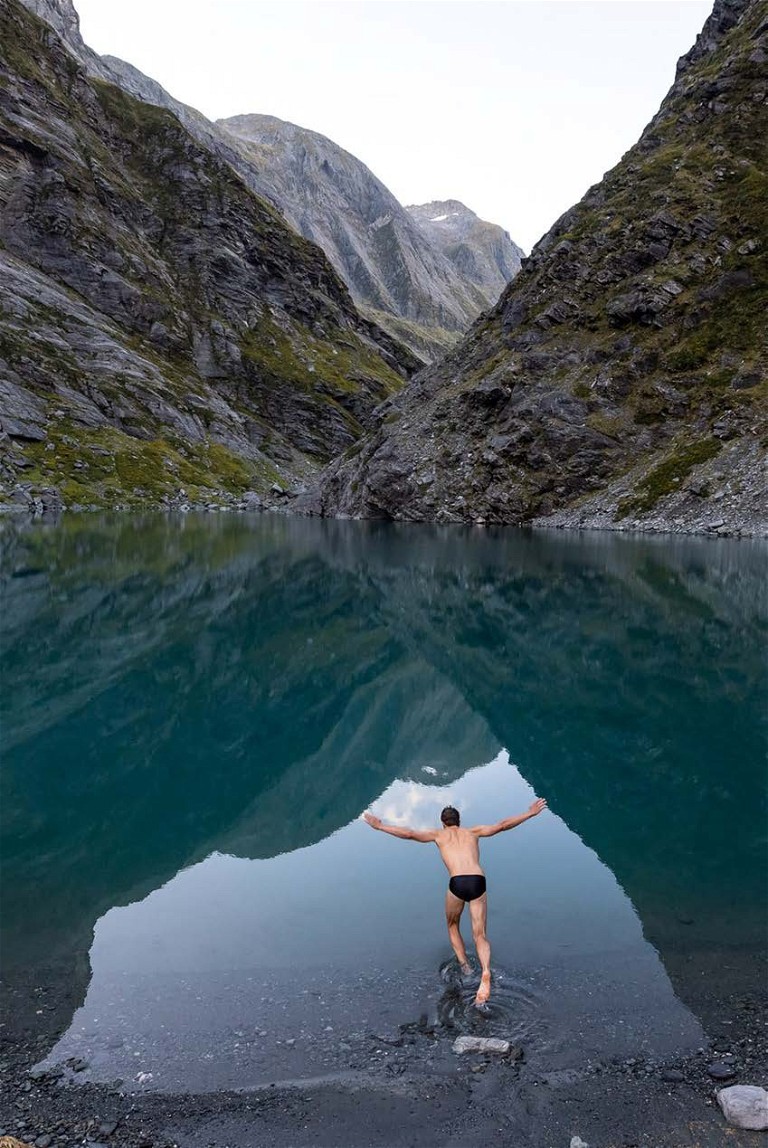
Photos by Graeme Murray @graememurraynz
C onnection: a word often used to describe something deep in the human psyche. It’s a hard concept to quantify, but one could say it’s the alignment of our energy and thoughts to something external – outdoor enthusiasts have a connection to the land that they explore, conservationists and hunters even more so. But connection isn’t solely physical; it’s a social and spiritual phenomenon, too. Connection creates attachment, and, more importantly, it fosters curiosity and understanding.
Such deep thoughts, however, were only a twinkle in Bob Mclachlan’s eyes as he assembled seven fair dinkum Aussie blokes and two Kiwis for a 3-night expedition into Mount Aspiring National Park – a trip that was aptly named ‘How Good’. In the hopes of preserving a few hectares of forest from going to print, ‘Big Water Bob’s’ credentials will not be mentioned in significant detail. But briefly: thanks to worldwide adventure-racing and pioneering feats in the discipline of white-water navigation, this bloke was like a duck to water when it came to the Kiwi outdoors. With his unassuming confidence and lightning wit, you couldn’t help trusting the man. This expedition was in Bob’s gargantuan yet safe hands.
Silhouetted by Hawea’s iconic mountains, preparations were made with the hustle and bustle of city life still labouring in the minds of the participants. Spearheaded in energy by the infectious chirp of Andrew ‘Reidy’ Reid – an integral member of the hit TV series Bondi Rescue – the rest of the expedition crew consisted of fellow Bondi lifeguards Ryan ‘Whippet’ Clarke and Ben Quigley; Hamish McMaster (AKA ‘Hammer’), the quietly determined Mark Liddell, the effervescent Dean Degan, creative geniuses Graeme Murray (photographer) and Zane Wilson (videographer), and guides Bob Mclachlan and me (Richie Laming). Some fellas were lifelong friends, others had only just met. It was the makings of one hell of a trip, but right now, only three things were on the agenda: blokes, beers, and banter.
While enjoying the simplest of luxuries – fresh bread and butter baked by Bob’s wonderful and caring wife, Cat (also the logistics superstar behind this trip) – we listened as Bob described the coming day’s activities: jet boating, glacial lake swimming, hiking, pack-rafting, heli-adventuring, mountain biking, and more. From the looks of wonder and awe sprinkled with apprehension, the trip was foreign territory to most.
Ben Quigley mentioned that his young son couldn’t understand how you could stand on top of a mountain because when you drew one on paper, the peak leaves no room for a person. Indeed, mountains of this grandeur appeared as a great unknown to most of the crew. It was left to the imagination as the crew departed for bed, bellies full to the brim, to sleep under a cloud of nervous excitement.
Ben Quigley mentioned that his young son couldn’t understand how you could stand on top of a mountain because when you drew one on paper, the peak leaves no room for a person. Indeed, mountains of this grandeur appeared as a great unknown to most of the crew. It was left to the imagination as the crew departed for bed, bellies full to the brim, to sleep under a cloud of nervous excitement.
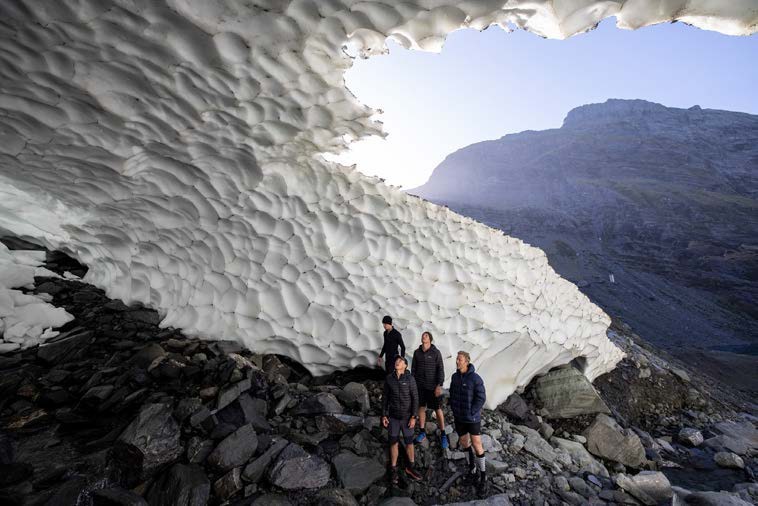
With Tuesday dawn bringing beautifully clear conditions, it naturally brought an air of optimism to the group as we checked equipment, hoarded snacks, double-checked maps, and filled packs. Then came departure time. Energy levels were high (there was more get up and go in the team than a one-night stand) and you could feel it. First stop: the Makarora River at the head of Lake Wanaka.
Here, our team would board the Wilkin River Jet. Light-hearted comparisons were made as packs were loaded into the jet boat, then, with a hiss and a roar, ‘How Good’ was a go. Glassy, windless conditions welcomed us up the Wilkin River as we made our first encounters with the type of terrain we would be immersed in over the following days.
Faces reflected quiet shades of intimidation as clear as the water below. After half an hour of disrupting the peace, horsepower transitioned to footpower as we disembarked from the last remnant of civilisation and waved goodbye to the jetboat. We had arrived at Kerin Forks Hut and, from there, would venture onwards to Top Forks Hut (a characterexposing 17km in the far distance).
Here, our team would board the Wilkin River Jet. Light-hearted comparisons were made as packs were loaded into the jet boat, then, with a hiss and a roar, ‘How Good’ was a go. Glassy, windless conditions welcomed us up the Wilkin River as we made our first encounters with the type of terrain we would be immersed in over the following days.
Faces reflected quiet shades of intimidation as clear as the water below. After half an hour of disrupting the peace, horsepower transitioned to footpower as we disembarked from the last remnant of civilisation and waved goodbye to the jetboat. We had arrived at Kerin Forks Hut and, from there, would venture onwards to Top Forks Hut (a characterexposing 17km in the far distance).
There was something pure about the following eight hours of hiking. Pure simplicity it was, as the persistent elements of nature have an unequivocal ability to strip back the layers that do not serve, exposing your core being. Strapped with 20-30kg of gear each, the hike presented a beautiful combination of native beech forest and river plains. Stimulated by the amphitheatre of wilderness, and disarmed from technology, we were able to fully appreciate the beauty surrounding us and engage in natural conversation. This was vital, as through some moments of the eight-hour long trek, we were hanging onto the words of our compatriots for motivation.
The first day’s journey was a good example of how hardship and vulnerability can create connection, and you would struggle to find a better arena for it than in the Southern Alps. There were moments of joy, of laughter, of struggle, and the pleasure of being in such a beautiful place. And, of course, there were those niggling self-doubts (which would only come out in the open a couple of days later). Hamish would later mention how he was haunted by the same peak, which never changed its position – an indication of how hardfought travel was.
Arriving triumphantly at Top Forks Hut at 5pm that evening, it was as if we were emerging from a time capsule. The experience of the last eight hours had been amplified into what felt like more. It sure had for Reidy, at least, who had already eaten his three days’ worth of snacks. With packs finally dropped, the crew took a muscle-salving dip in the upper reaches of the Wilkin River. A refreshed vibe overtook camp as tents were erected and the primal aroma of a campfire enveloped the air. Whippet, a self-confessed pyromaniac, took it upon himself to source the wood required with a gusto not seen since cold beers were introduced the previous evening. Those beers sure did seem a long time ago now.
With socks and shoes out to dry, bowls were filled (as was morale) with some of Cat’s homemade Bolognaise. The twinkle of distant stars framed by silhouetted peaks provided an evening backdrop like none of us had ever seen before. Then the natural boredom set in. ‘Boredom’ usually has a negative connotation, but place ‘natural’ in front of it and the phrase describes the wonderful things that happen when you escape societal pressures and immerse yourself in wilderness – evolution.
The Oxford English Dictionary defines ‘evolve’ as “to develop gradually,” On the outskirts of Mount Aspiring National Park that evening, small changes were gradually developing in everyone. Around the campfire, the crew shared and exchanged new learnings with one another. As we settled in for that first night, the gentle flow of the nearby Wilkin River carried our thoughts away, and the smell of our tent partner’s flatulence…
The Oxford English Dictionary defines ‘evolve’ as “to develop gradually,” On the outskirts of Mount Aspiring National Park that evening, small changes were gradually developing in everyone. Around the campfire, the crew shared and exchanged new learnings with one another. As we settled in for that first night, the gentle flow of the nearby Wilkin River carried our thoughts away, and the smell of our tent partner’s flatulence…
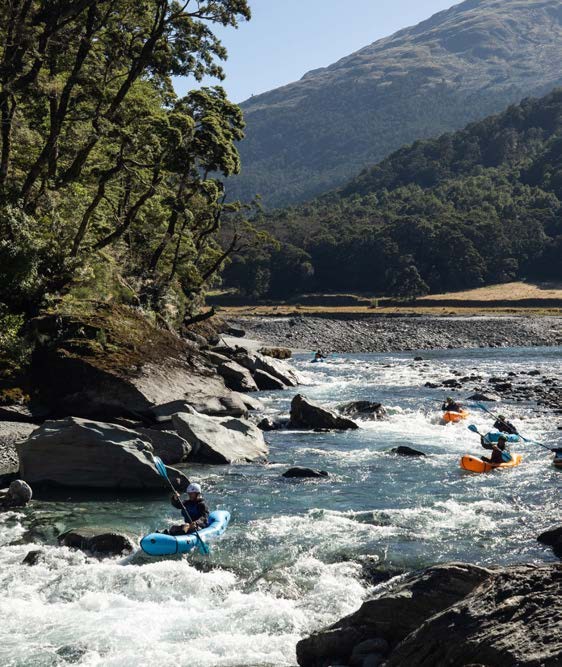
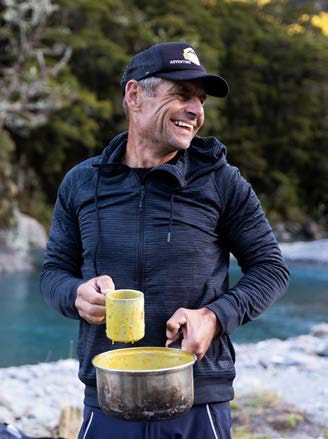
There are iconic voices everyone can recognise: Bruce Buffer, the American ring announcer; Ray Warren, the Australian sports presenter; and Bob Mclachlan, the larger-than-life Kiwi outdoorsman, at 6am. With Bob’s humming commentary acting as a natural alarm clock, the team was roused slightly stiff. Yet, with the first breath of fresh alpine air, morale was ignited again. A tummy-warming concoction of porridge and cream followed before camp was packed and the destination outlined for that day: Lake Castalia, a glacial-filled lake rising 500 metres above us. With approximately six hours of pack-hiking ahead, a line of nine evolving humans departed Top Forks for the mystery that was Lake Castalia, and a day of natural stimulus soon to be etched into our minds.
Surrounded in all directions by magnificent beech forest and masses of glacial ice, as the clock hit 11am the ferocious rumbling of ice falls began with the thaw of the summer sun. There was a cacophony of “Oooohs” and “Aaaahs” from the crew as containersized chunks of ice plummeted hundreds of metres. Graeme and Zane were in the zone capturing the foreground of hikers amplified by the awe-inspiring backdrop. The team were completely safe on the trail, spectating from afar as we explored the two lake systems preceding Lake Castalia: Lake Diana and Lake Lucidus. We took our lunch at a small glacial-fed swimming hole in the north branch of the Wilkin River – where Zane showed his true-blue roots with a pair of cracking budgie smugglers – before we pushed the final couple of hours onto Lake Castalia.
Surrounded in all directions by magnificent beech forest and masses of glacial ice, as the clock hit 11am the ferocious rumbling of ice falls began with the thaw of the summer sun. There was a cacophony of “Oooohs” and “Aaaahs” from the crew as containersized chunks of ice plummeted hundreds of metres. Graeme and Zane were in the zone capturing the foreground of hikers amplified by the awe-inspiring backdrop. The team were completely safe on the trail, spectating from afar as we explored the two lake systems preceding Lake Castalia: Lake Diana and Lake Lucidus. We took our lunch at a small glacial-fed swimming hole in the north branch of the Wilkin River – where Zane showed his true-blue roots with a pair of cracking budgie smugglers – before we pushed the final couple of hours onto Lake Castalia.
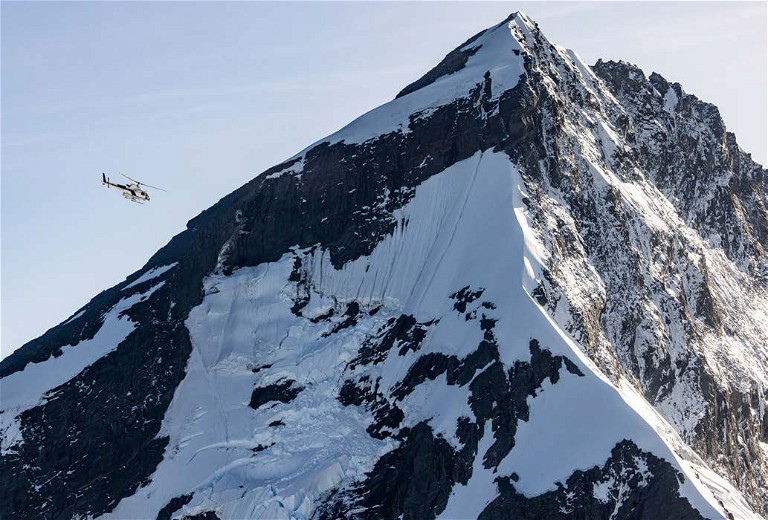
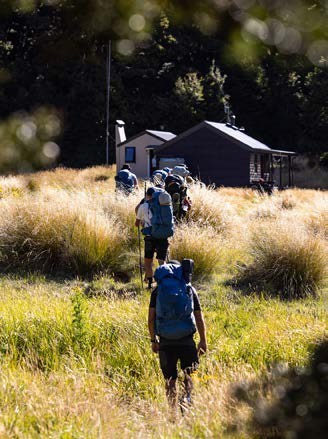
As we advanced towards Lake Castalia, all was hidden by mammoth pieces of rock. Then, with a final turn that signalled the end of the prehistoric labyrinth, a view greeted us unlike anything that had come before. It wasn’t just that it was a lake shimmering in brilliant turquoise, it was the enitre cradle the lake was encased within that blew our minds. All around were cliff faces so sheer and dominating that it was impossible to gain scope of how large they were. At least 15 waterfalls cascaded down the rockfaces, and with each gusting wind, the waterfalls became waterclimbs – forced against their will in a battle of the elements. Better still, the setting sun created a rainbow effect on the water droplets, which was described as “like a scene from Interstellar”. In other words, out of this world. Mark revealed later that up until this point in his life, he had no idea that such places truly existed. Frothing with energy, we then made our way around to the lake’s northern end. With nothing to do but build a camp, eat food, and share in each other’s company, life really had become pure and simple for our motley crew of nine lads. We had nothing but time. Time to imprint what we had seen as a memory to relish later, like a reservoir that could be drawn upon in tough times; time to enjoy the magic of being ‘off-grid’, far from the day-to-day struggles of everyday life; and time to connect with each other spiritually, beyond the superficial. With the added bonus of an early morning ice cave exploration to look forward to the next day, we resigned to our beds that night with our metaphorical cups brimming full.
With the following morning bringing serene conditions, we ventured up to a remnant ice formation tucked into the western flank of the surrounding cliffs. It was here that the scale of the land became more fathomable. What appeared to be a black dot from camp turned out to be an archway receding into the ice, approximately 5m tall by 10m wide. It was as if nature’s genius had created this spectacle just for the ‘How Good’ crew to enjoy. After an hour spent in awe of this icy wonderland, we began the return journey, spurred on by the thought of the biggest sensory stimulus yet to come: a helicopter flight over Mount Aspiring itself.
Rene Daumal famously said, “You cannot stay on the summit forever; you have to come down again. So why bother in the first place?” No words were more poignant as the crew took one last glance at the extraordinary Lake Castalia. The answer became clear over the following hours as we returned to the Top Forks Hut: “One climbs, one sees. One descends, and one sees no longer. But one has seen.” Our eyes had been opened, our egos had been humbled, and our spirits had flown over the previous 24 hours. A calm had descended upon the crew, and although the task was still arduous, the crew were in sync, in rhythm.
Under the lowering sun, we ventured on to Jumboland, approximately 6km back down the main branch of the Wilkin River. A cold-water bath and another rock jump helped us cleanse those hardto-reach places. As we savoured our dinner of mash and curry, the crew stared into the campfire and reflected on how the time we had known each other seemed irrelevant, as the lack of artificial distraction had allowed a rapid connection to be forged between us. It made us realise that despite the different ages of the crew – ranging from 30s to 50s – the concept of age in the pursuit of the outdoors is irrelevant; it’s the energy that counts! Bob, with a mending leg that he’d broken several months prior, was a testament to this. As Graeme experimented with some stellar photography, the crew retired in gentle anticipation of the next morning’s excitement.
Doofdoof...doofdoof... a rumble filled the valley as two metal birds descended from the sky. In what Dean later described as a Vietnam reenactment, we boarded the choppers and a new dose of adrenaline surged for the last action-packed day. Within minutes, the crew was navigating country as beautiful as it was hostile. Sheer cliff faces opened to cascading waterfalls, and chunks of glacial ice desperately hung on. Mt Aspiring, standing 3033m above sea level, captivated our attention as it dominated the landscape. It was easy to see why helicopters had become so relied upon here. Thousands of feet up this day, the view gave the impression that if the land were pulled flat, it would double in size – easily. There was so much terrain, but in a stone’s throw, you could be anywhere. When we reached the famous Coxcomb ridge, it was like seeing beyond 3D, as if the brain just didn’t know how to process it. Before we could recalibrate our thoughts, the choppers were sweeping down into the upper M tukituki valley, where we would begin our pack-rafting section. The looks were unanimous as the crew disembarked after the 30-minute sojourn. Time had just stood still for us, and we had just visited an entirely different realm.
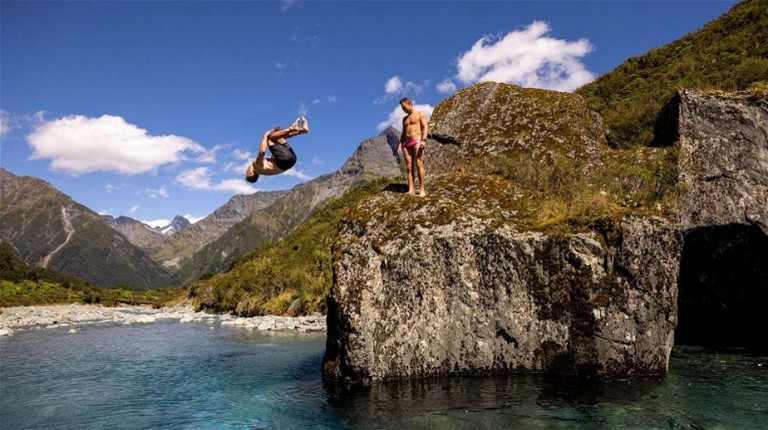
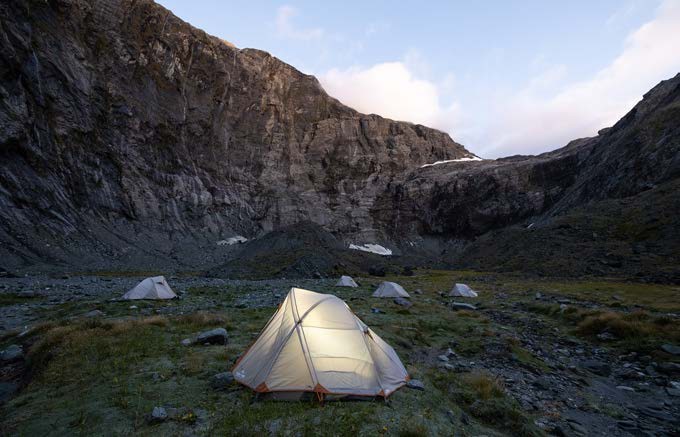
Pack-rafting, or “Pek Raftin,” as Reidy playfully put it, has revolutionised river travel. To the Aussies, the water was their playground, and it was their time to shine in the M tukituki River’s grade 2/3 rapids. Once briefed by Bob, with helmets and life jackets in tow, the boys hit the river in rafts of their own. Crystal-clear waters were kissed by sparkling sun rays as our train of rafts navigated between the hills and crept slowly back to society. Allowing the river’s flow to navigate our pathway, we took several stops to explore the myriad of waterfalls, glacial backdrops, and native forests which adorned the skyline. It really was a lovely way to relax and chew the fat, knowing the looming wave of civilisation was creeping ever closer. With the last of the rapid sections providing a flutter of excitement, after 2.5 hours, we finally neared the pickup point. There was Cat, the superstar behind the trip, waving at us from the river’s edge.
It was a sentiment shared by all and best described by Bob: that first glimpse of civilisation came with a slight battle of emotional thought. Images of family and friends, home and hot showers suddenly flooded into our minds, but this was opposed by a deep longing and regret that our time in the wilderness could not continue, that simplicity would be replaced by complexity. In one way or another, each of us had challenged ourselves mentally and/or physically in ways we hadn’t before. This was a huge growth space. But with that first temptation of comfort, the romance of the wild gripped at our rafts and challenged our priorities. That, it must be said, is the devilish charm of the NZ backcountry.
All was not over yet, however. With rafts dismantled, it was off to the Glendu Bike Park for a rip before retiring to the luxuries of H wea View Lodge. It was the perfect way to spend the last couple of hours of an actionpacked Friday, and with everyone sized-up on an e-bike of their own, the simple objective was to summit the trail mountain and then descend back to base. Admittedly, some sore bodies ensured the E-bikes stayed in ‘turbo’ mode, and the subsequent energy that was conserved ensured a fun descent. I’ve heard it said that people love to mountain bike because they are chasing a state of flow. But what is flow? As Hamish descended that day, he described a complete removal from everything he had experienced – he was purely present. But once he stopped, incredible images from the last few days returned to resettle in his mind in an even clearer state. It was like experiencing the highlights of the trip all over again.
Tssskkk. It was music to the ears. The cap being ejected off a bottle and that first sip of beer was divine nectar. It’d be fair to say that the beer wasn’t just being ingested, it was being absorbed via osmosis – the cells were craving it. With the bikes offloaded, we settled into the luxuries of the lodge. On the back of a trip where wet feet, blood blisters, and pack rash had become the norm, it was a brilliant contrast. There was local food expertly prepared by Chef Andy, waterskiing, wakeboarding, swimming, and a wonderful spa with show-stopping views. But, above all, it was the moments of vulnerability that were the most memorable at the lodge, kickstarted by that arduous pack-hike all those days ago. Around the dinner table, the ping pong table, or lakeside, connections continued to be developed. Tears were spilt as the positive and negative aspects of the trip were revisited. It was an amazing feeling. We each came seeking adventure but were left cradling the precious connections and our shared understanding. Simply put, the crew didn’t want to be anywhere else. For at least this week, we had disconnected from the world and reconnected with ourselves.